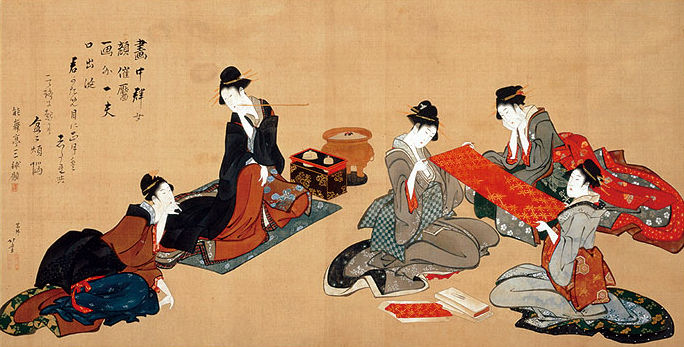Tanka Poetry: A Window into the Heart of Japanese Literature
- torinaga11
- Jan 2
- 3 min read

Tanka poetry is a timeless and evocative form of Japanese literature that has been cherished for over a millennium. As one of the oldest poetic forms in Japan, tanka serves as a bridge between the past and the present, offering a glimpse into the emotions, experiences, and aesthetics of Japanese culture. Rooted in brevity and elegance, the tanka form encapsulates profound emotions and vivid imagery in just 31 syllables.
What is Tanka Poetry?
The word tanka translates to "short poem" in Japanese. This poetic form consists of five lines with a 5-7-5-7-7 syllabic structure. Unlike haiku, which focuses on nature and has a stricter thematic constraint, tanka is more expansive, exploring themes of love, longing, nature, and human emotions. Its brevity encourages poets to distill their thoughts and feelings into compact yet profound expressions.
A typical tanka can be divided into two sections:
The first three lines (5-7-5) often introduce a scene or emotion.
The last two lines (7-7) provide reflection, commentary, or resolution.

Historical Origins
Tanka poetry dates back to the Manyoshu ("Collection of Ten Thousand Leaves"), Japan’s oldest anthology of poetry compiled in the 8th century. In this collection, tanka was the dominant poetic form, reflecting the voices of emperors, courtiers, and commoners alike. Its prominence continued during the Heian Period (794-1185), where it flourished in aristocratic circles.
During this time, tanka was an essential part of courtship. Lovers would exchange tanka as a form of communication, embedding their feelings into artful lines. This period also saw the rise of waka poetry, of which tanka was a subset. Waka became a critical cultural element in courtly life, with nobles composing tanka during social gatherings and seasonal festivals.
The Aesthetics of Tanka Poetry
Tanka embodies the Japanese aesthetic principles of wabi-sabi (finding beauty in imperfection and transience) and yugen (profound grace and subtlety). Through these principles, tanka poets often evoke a sense of fleeting beauty and emotional depth. Common themes include:
Nature: Cherry blossoms, autumn leaves, and the moon are frequent motifs, symbolizing the ephemeral nature of life.
Love and Longing: Tanka often captures the joys and sorrows of love, including unrequited affection and separation.
Seasonal Imagery: Each season is depicted with nuanced detail, reflecting the poet’s connection to the natural world.

Notable Tanka Poets
Ono no Komachi (9th Century)
Renowned for her beauty and poetic talent, Ono no Komachi’s tanka explore themes of love, passion, and melancholy. Her works remain some of the most celebrated in Japanese literature.
Example:
The colors of the flowershave faded in vain,as I reflect on myself,wondering if my lovewill likewise fade away.
Ki no Tsurayuki (872–945)
A court poet and one of the compilers of the Kokinshu (Collection of Ancient and Modern Poems), Tsurayuki’s tanka exemplify the elegance and emotional depth of the Heian era.
Tanka in Modern Times
While its prominence waned with the rise of haiku in the 17th century, tanka experienced a revival during the Meiji Period (1868–1912). Poets like Masaoka Shiki modernized tanka, bridging traditional forms with contemporary themes.
In today’s world, tanka continues to resonate with poets globally. Modern tanka often delves into personal struggles, urban life, and global issues, showcasing its adaptability across cultures and eras.
Writing Your Own Tanka
Crafting a tanka requires precision and imagination. Here’s a guide to help you get started:
Choose a Theme: Reflect on personal emotions or natural scenery.
Embrace the 5-7-5-7-7 Structure: While adhering to this syllable count, focus on conciseness and vivid imagery.
Incorporate a Twist: Use the final two lines to add depth or contrast to the initial lines.
Infuse Emotion: Let the poem capture a moment of profound feeling or reflection.
Example:
In autumn’s cool breeze,crimson leaves drift to the ground,fleeting memories—the warmth of your gentle hand,now as distant as the stars.

Tanka's Global Appeal
Tanka’s universal themes and simplicity have made it a global phenomenon. English-language tanka, while often free from strict syllable rules, retains the form's spirit. Poetry communities worldwide celebrate tanka through anthologies, contests, and workshops, ensuring its enduring legacy.
Tanka poetry stands as a testament to the power of brevity and emotion. From its aristocratic roots in Heian Japan to its modern iterations, tanka has captured the essence of human experience in just 31 syllables. Whether reflecting on the beauty of nature, the complexities of love, or the passage of time, tanka invites readers and writers alike to pause, reflect, and connect. Through its timeless elegance, tanka continues to inspire and resonate, bridging the past with the present in a shared appreciation of life’s fleeting moments.





Comments